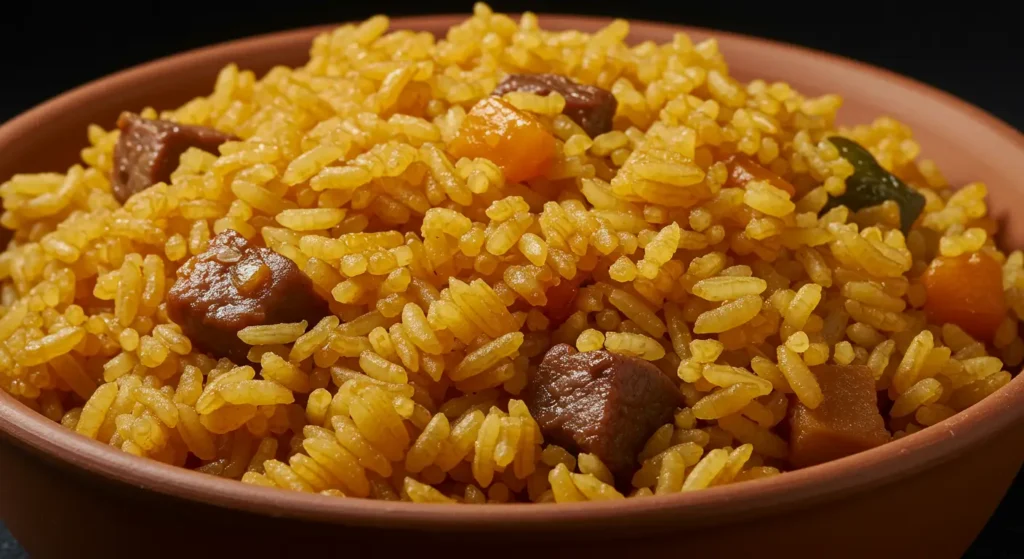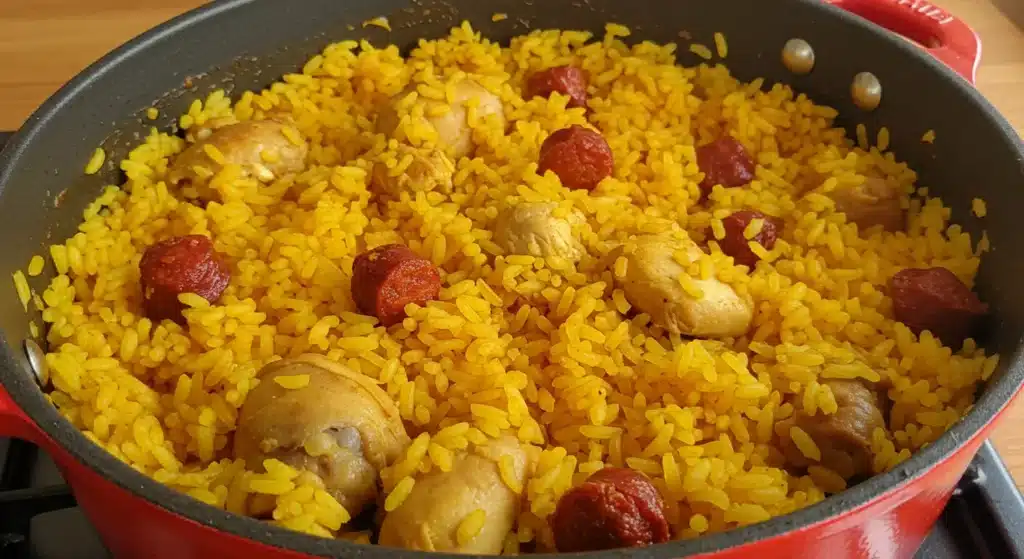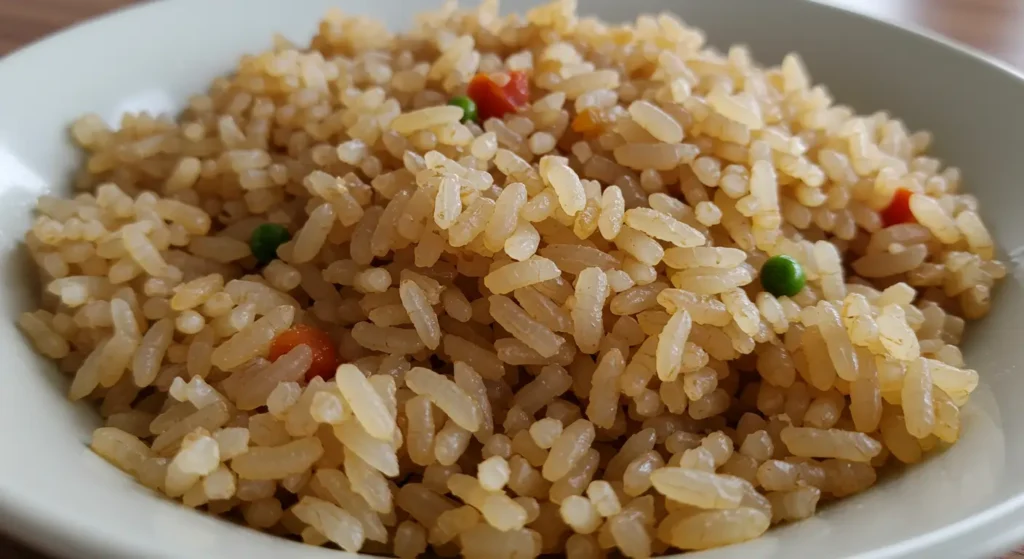Authentic Spanish Rice: A Savory Spanish Staple
Table of Contents
Discover the Flavors of Spain with a traditional dish that embodies the heart of Spanish cuisine: Spanish rice. This savory staple is more than just a side dish; it’s a reflection of Spain’s rich culinary heritage.
You might be familiar with various versions of rice dishes from around the world. But the authentic version from Spain has its unique charm. It’s a simple yet flavorful recipe that complements a wide range of Spanish meals.
In this article, you’ll learn how to prepare this beloved dish. We’ll dive into the key ingredients and methods that make this dish a cornerstone of Spanish cuisine.
Key Takeaways
- Understand the significance of Spanish rice in Spanish cuisine.
- Learn the basic ingredients for an authentic Spanish rice recipe.
- Discover simple techniques to elevate your Spanish rice dish.
- Explore variations of the recipe to suit different tastes.
- Get tips on serving Spanish rice with other Spanish dishes.
The Rich Heritage of Spanish Rice
Spanish rice is a key part of Spanish cuisine, with a history that goes back centuries. It holds strong ties to Spain’s rich cultural heritage and culinary traditions.
Origins and Cultural Significance
Spanish rice started in Valencia, shaped by the Moors and the Mediterranean diet. It’s now a big part of Spanish identity. It brings families together during special occasions.
Spanish Rice vs. Mexican Rice: Understanding the Difference
Spanish and Mexican rice are two different dishes, each with its own taste and ingredients. Spanish rice, or “paella,” has saffron, seafood, and veggies. Mexican rice, on the other hand, uses tomatoes, onions, and spices. Knowing these differences helps us enjoy each dish’s unique flavor.
Essential Ingredients for Authentic Spanish Rice
To make authentic Spanish rice, you need the right ingredients. The quality of the ingredients plays a crucial role in shaping the dish’s flavor and texture.
The Perfect Rice Varieties to Use
Bomba rice is the top choice for Spanish rice. It absorbs flavors well without getting mushy. Calasparra and Senia are also good options for their absorption abilities.
Traditional Aromatics and Spices
Onions, garlic, and tomatoes are key for Spanish rice’s rich taste. Spices like paprika (pimentón) and saffron add depth and color.
The Importance of Quality Saffron
Saffron is vital for Spanish rice’s yellow color and unique taste. Using high-quality saffron threads is crucial for the best flavor.
| Ingredient | Description | Importance |
|---|---|---|
| Bomba Rice | A short-grain rice variety | High |
| Saffron | High-quality saffron threads | High |
| Paprika (Pimentón) | Smoked or sweet paprika | Medium |
| Aromatics | Onions, garlic, tomatoes | High |
Tools and Equipment for Perfect Spanish Rice
Cooking Spanish rice needs more than just the right ingredients. It also requires the right cooking vessels. The type of cookware you use can greatly affect the final dish. So, it’s crucial to pick the right tools for an authentic Spanish rice experience.
Traditional Paella Pans
Traditional paella pans are key in Spanish cooking, for making authentic Spanish rice. These pans distribute heat evenly, ensuring a perfect socarrat (the crispy rice layer at the bottom). Made from carbon steel or stainless steel, they are durable and work well on various heat sources, like gas stoves and outdoor grills.
- Carbon steel paella pans are known for their heat conductivity.
- Stainless steel paella pans are durable and resistant to corrosion.

Modern Alternatives for Home Cooking
While traditional paella pans are the best, modern alternatives can also yield great results for home cooks. Options include non-stick pans, cast-iron skillets, and electric paella pans, each with its own benefits. Non-stick pans prevent rice from sticking, cast-iron skillets hold heat well, and electric paella pans offer controlled cooking.
- Non-stick pans for easy food release and cleaning.
- Cast-iron skillets for excellent heat retention.
- Electric paella pans for precise temperature control.
Mastering Authentic Spanish Rice: Step-by-Step
Spanish rice is a key part of Spanish food. It needs patience and care to make it right. You’ll learn how to pick the best ingredients and cook it perfectly.
Preparing Your Ingredients
The best Spanish rice starts with the right ingredients. Choose Calasparra or Bomba rice for its flavor absorption. Then, prepare onions, garlic, and tomatoes for the base flavor. Remember to have saffron threads for the rice’s color and taste.
The Cooking Process
Cooking Spanish rice is a detailed process. Start by heating olive oil in a paella pan or skillet. Sauté the aromatics until they’re soft. Then, add the rice, mixing it with oil and aromatics.
Next, add broth with saffron and spices. Bring it to a simmer, then lower the heat. Let it cook, uncovered, until the liquid is gone and the rice is tender.
Achieving the Perfect Socarrat (Bottom Crust)
The socarrat is the crunchy, golden layer of rice at the bottom of Spanish rice dishes. To achieve it, increase the heat for a few minutes after cooking and listen for a crackling sound, but be cautious not to let it burn—aim for a perfectly crispy finish.
By following these steps and being patient, you’ll make a delicious Spanish rice dish. It will impress with its flavors and the perfect socarrat.

Regional Variations of Spanish Rice Dishes
Exploring Spain’s diverse culinary scene reveals a rich tapestry of rice dishes. Each region adds its own twist to traditional recipes. This reflects local ingredients, cultural influences, and historical traditions.
Valencia’s Paella
Valencia is famous for Paella, a dish that symbolizes Spanish cuisine. It’s cooked in a shallow pan over an open flame. This creates a crispy crust called the socarrat at the bottom.
Valencia’s Paella combines chicken, rabbit, and vegetables. It showcases the region’s rich agricultural heritage.
Arroz Negro from Catalonia
Arroz Negro, also known as black rice, is a distinctive dish from Catalonia. Its rich black hue comes from squid ink, and the rice is cooked with seafood such as shrimp, mussels, and cuttlefish.
The squid ink not only gives the rice a striking color. It also adds a deep, oceanic flavor.
Arroz con Leche: The Sweet Side
Arroz con Leche, or rice pudding, is a sweet treat in Spain. It’s made with short-grain rice, milk, sugar, and cinnamon. Sometimes, lemon zest is added for extra flavor.
This creamy dessert is a favorite in many Spanish homes. Its creamy texture and sweetness make it a perfect ending to a meal.
Common Mistakes to Avoid When Cooking Spanish Rice
Cooking Spanish rice well means avoiding common mistakes. This dish, known as “Arroz Español,” needs careful attention to get its unique flavors and textures right.
Rice Selection and Preparation Errors
Choosing the wrong rice is a big mistake. Spanish rice recipes usually ask for Calasparra or Bomba rice. These types soak up flavors well without becoming mushy. Regular long-grain rice can make the dish too soft.
Also, not rinsing the rice before cooking can cause it to stick together. This is because of excess starch.
Temperature and Timing Issues
Finding the right cooking temperature and timing is essential. If the heat is too high, the socarrat (crispy bottom layer) may burn before the rice is fully cooked, while cooking it too slowly can prevent the socarrat from forming.
It’s also crucial to cook the rice just until it’s done—overcooking can result in a mushy texture.

| Mistake | Correction |
|---|---|
| Using the wrong type of rice | Use Calasparra or Bomba rice |
| Not rinsing the rice | Rinse rice before cooking |
| High cooking heat | Adjust heat to prevent burning |
| Overcooking | Cook until the rice is just done |
Nutritional Benefits and Serving Suggestions
Spanish rice is a key part of Spanish cuisine. It’s full of nutrients and can make your meals healthier. This dish mixes rice with veggies, spices, and sometimes proteins, making it a complete meal.
Health Profile of Spanish Rice
Spanish rice is good for you because of its ingredients. Rice gives you carbs, while veggies add fiber, vitamins, and minerals. Spices like saffron and paprika boost flavor and offer antioxidants.
Traditional and Modern Pairings
There are many ways to enjoy Spanish rice. Traditionally, it goes well with grilled meats or seafood. For something new, try it with roasted veggies or as a salad base. Try different combinations to find your favorite.
Adding Spanish rice to your meals can make them tastier and healthier. It’s a satisfying and nutritious choice.
Conclusion: Bringing Authentic Spanish Flavors to Your Table
You now know how to make authentic Spanish rice dishes. These dishes bring the tastes of Spain right to your table. You’ve learned about the rich heritage, key ingredients, and cooking methods.
Try out different Spanish rice dishes, like Valencia’s Paella or Arroz Negro from Catalonia. This will make your cooking more interesting. As you get better, you’ll learn to make the perfect socarrat and balance the flavors.
Now, you can make delicious Spanish dishes that will wow your loved ones. So, get your ingredients ready, heat up your paella pan, and start cooking. Enjoy a taste of Spain in your own home.
FAQ
What is the difference between Spanish rice and Mexican rice?
Spanish rice comes from Spain and often includes saffron, vegetables, and seafood or meat. Mexican rice, on the other hand, is a key dish in Mexican food. It’s made with tomatoes, onions, and spices. The two dishes have very different tastes and ingredients.
What type of rice is best for authentic Spanish rice?
For real Spanish rice, use short-grain rice like Calasparra or Bomba. These types soak up flavors well and have the right texture.
Can I make Spanish rice without saffron?
Yes, you can make Spanish rice without saffron. But remember, saffron is what gives it its unique taste and color.
What is socarrat, and how do I achieve it?
Socarrat is the crispy, caramelized layer at the bottom of Spanish rice. To get it, cook the rice over high heat for a short time. This lets the bottom layer crisp up.
Can I use a non-stick pan to cook Spanish rice?
You can cook Spanish rice in a non-stick pan, but it’s not the best choice. Traditional pans like paella pans or large, shallow skillets are better for getting a crispy socarrat.
How do I store leftover Spanish rice?
Store leftover Spanish rice in an airtight container in the fridge for up to 3 days. When reheating, add a bit of water to keep it moist.
What are some common variations of Spanish rice?
There are many types of Spanish rice, like Valencia’s paella and Arroz Negro from Catalonia. There’s also Arroz con Leche, a sweet dessert version.
Is Spanish rice gluten-free?
Spanish rice is usually gluten-free because it’s made with rice, veggies, and spices. But watch out for any gluten in added ingredients.

